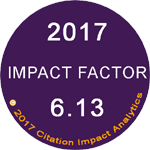© 2016-18, www.jrps.in , All rights Reserved.
Disclaimer | Privacy Policy | Terms & Conditions | Help Desk | SiteMap
Disclaimer | Privacy Policy | Terms & Conditions | Help Desk | SiteMap
Impact Factor
Impact Factor is a measure of the frequency with which the "average or any article" published in a given ( JRPS ) journal has been cited in a particular year or period and is often used to measure or describe the importance of a particular journal to its field.
International Journal for Research Paper & Publication (JRPS)’s impact factor for 2015 has been calculated by taking the number of citations in 2015 from articles or research papers that were published in 2013 and 2014 and dividing that number by the total number of articles published in that same journal in 2013 and 2014.
International Journal for Research Paper & Publication (JRPS)’s are among the best open access Multi-disciplinary journals in the world, set out to publish the most comprehensive, relevant and reliable information based on the current research and development on a variety of subjects. The inclusion of these publications provides the opportunity for editors and publishers to manipulate the ratio used to calculate the impact factor and try to increase their number rapidly.
Impact factors have a huge, but controversial, influence on the way published scientific research is perceived and evaluated. Numerous criticisms have been made of the system but:
•The above mentioned Impact factors are useful metrics for the comparison of JRPS and their influence within a field.
•These Impact factors are not infallible measures of JRPS international journals quality.
Furthermore, in a journal which has long lag time between submission and publication, it might be impossible to cite articles within the three-year window. Indeed, for some journals, the time between submission and publication can be over two years, which leaves less than a year for citation. Whereas JRPS international journals follow rapid review process to publish the manuscripts as quickly as possible after acceptance. In JRPS, the editorial office is dedicated to ensure the peer review process of the manuscripts by the eminent editors and the reviewers to raise the quality of publishing.
Different ways how the impact factor is measured is described below:
5 Year Journal Impact Factor
The 5 year journal impact factor is the average number of times articles published in the journal in last 5 years has been cited in the Journal Citation Reports year. It is calculated by dividing the number of citations in the Journal Citation Reports year by the total number of articles published in previous five years. The 5 year impact factor is available only for Journal Citation Reports 2007 and following years. The 5 year Impact factor can be calculated using an earlier Journal Citation Reports year as a starting point by following these instructions.
Aggregate Impact Factor
The aggregate impact factor for a subject category is calculated using the same method as the impact factor for a journal, but it also includes the number of citations for all journals in the category and the number of articles from all journals in the category. An aggregate impact factor of 2.32 implies that the articles in the subject category published in recent two years have been cited once on an average. The median Impact factor is the median value of all journals’ impact factors in the subject category. The impact factor extenuates the significance of absolute citation frequencies. It alleviates the advantage of large journals over small journals because large journals turn out a larger body of citable literature. It also mitigates the benefit of frequently issued journals over less frequently issued ones and of older journals over newer ones. For the reason that the journal impact factor offsets the advantages of size and age, it is a helpful contrivance for journal evaluation.
Impact Factor Trend Graph
The Impact Factor Trend Graph exemplifies the Impact Factor for a five-year period. To view the graph, click the Impact Factor Trend button at the top of the Journal page.
X = the number of times, articles published in 2010 and 2011, were cited by indexed journals during 2012
Y = the total number of "citable items" published by that journal in 2010 and 2011.
2012 impact factor = X/Y
Evaluation / Calculation of Impact Factor :
Impact calculation has been calculated in the following way:
1) A search was conducted for each article published in the Journal during 2013 and 2014.
2) The resulting citation list for each article was then cleaned to identify only those citations that were made in 2015.
3) Because Google Scholars more encompassing than the Science Citation Database or Social Science Citation Database, and captures citations also by books, national reports,etc. the resulting 2015 citation list was further cleaned such that it contained only citations made in peer reviewed journals.
4) The impact factor was then calculated by dividing the total number of citations made in 2013 to articles published in 2013 and 2014 by the total number of citable items.
International Journal for Research Paper & Publication (JRPS)’s impact factor for 2015 has been calculated by taking the number of citations in 2015 from articles or research papers that were published in 2013 and 2014 and dividing that number by the total number of articles published in that same journal in 2013 and 2014.
International Journal for Research Paper & Publication (JRPS)’s are among the best open access Multi-disciplinary journals in the world, set out to publish the most comprehensive, relevant and reliable information based on the current research and development on a variety of subjects. The inclusion of these publications provides the opportunity for editors and publishers to manipulate the ratio used to calculate the impact factor and try to increase their number rapidly.
Impact factors have a huge, but controversial, influence on the way published scientific research is perceived and evaluated. Numerous criticisms have been made of the system but:
•The above mentioned Impact factors are useful metrics for the comparison of JRPS and their influence within a field.
•These Impact factors are not infallible measures of JRPS international journals quality.
Furthermore, in a journal which has long lag time between submission and publication, it might be impossible to cite articles within the three-year window. Indeed, for some journals, the time between submission and publication can be over two years, which leaves less than a year for citation. Whereas JRPS international journals follow rapid review process to publish the manuscripts as quickly as possible after acceptance. In JRPS, the editorial office is dedicated to ensure the peer review process of the manuscripts by the eminent editors and the reviewers to raise the quality of publishing.
Different ways how the impact factor is measured is described below:
5 Year Journal Impact Factor
The 5 year journal impact factor is the average number of times articles published in the journal in last 5 years has been cited in the Journal Citation Reports year. It is calculated by dividing the number of citations in the Journal Citation Reports year by the total number of articles published in previous five years. The 5 year impact factor is available only for Journal Citation Reports 2007 and following years. The 5 year Impact factor can be calculated using an earlier Journal Citation Reports year as a starting point by following these instructions.
Aggregate Impact Factor
The aggregate impact factor for a subject category is calculated using the same method as the impact factor for a journal, but it also includes the number of citations for all journals in the category and the number of articles from all journals in the category. An aggregate impact factor of 2.32 implies that the articles in the subject category published in recent two years have been cited once on an average. The median Impact factor is the median value of all journals’ impact factors in the subject category. The impact factor extenuates the significance of absolute citation frequencies. It alleviates the advantage of large journals over small journals because large journals turn out a larger body of citable literature. It also mitigates the benefit of frequently issued journals over less frequently issued ones and of older journals over newer ones. For the reason that the journal impact factor offsets the advantages of size and age, it is a helpful contrivance for journal evaluation.
Impact Factor Trend Graph
The Impact Factor Trend Graph exemplifies the Impact Factor for a five-year period. To view the graph, click the Impact Factor Trend button at the top of the Journal page.
X = the number of times, articles published in 2010 and 2011, were cited by indexed journals during 2012
Y = the total number of "citable items" published by that journal in 2010 and 2011.
2012 impact factor = X/Y
Evaluation / Calculation of Impact Factor :
Impact calculation has been calculated in the following way:
1) A search was conducted for each article published in the Journal during 2013 and 2014.
2) The resulting citation list for each article was then cleaned to identify only those citations that were made in 2015.
3) Because Google Scholars more encompassing than the Science Citation Database or Social Science Citation Database, and captures citations also by books, national reports,etc. the resulting 2015 citation list was further cleaned such that it contained only citations made in peer reviewed journals.
4) The impact factor was then calculated by dividing the total number of citations made in 2013 to articles published in 2013 and 2014 by the total number of citable items.

International Journal for
Research Publication and Seminar
Research Publication and Seminar
ISSN : 2278-6848
